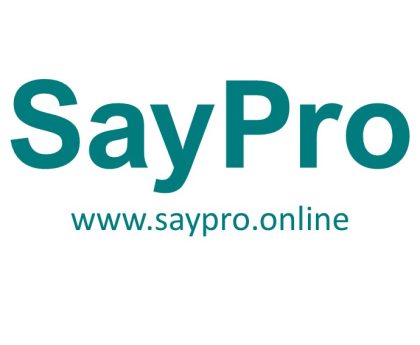SayPro Perform weekly code reviews for SayPro development tasks from SayPro Monthly February SCMR-17 SayPro Monthly IT Services: Software development, cybersecurity, and IT support by SayPro Online Marketplace Office under SayPro Marketing Royalty
Overview
During February, the SayPro development team maintained a rigorous process of performing weekly code reviews for all ongoing development tasks. These reviews are integral to ensuring code quality, security, maintainability, and alignment with SayPro’s coding standards and project requirements. Weekly code reviews foster collaboration, early identification of issues, and continuous improvement in the software development lifecycle.
Code Review Process
1. Scheduling and Scope
- Weekly code reviews were scheduled every Friday afternoon, providing developers the opportunity to submit their work completed during the week.
- Reviews covered all active feature branches, bug fixes, and patches ready for integration or staging environment testing.
- The scope included both frontend and backend codebases, including API services, user interface components, and database scripts.
2. Participants and Roles
- The code review sessions involved senior developers, tech leads, and the quality assurance (QA) team to provide multi-dimensional feedback.
- Developers who authored the code actively participated to explain design decisions and clarify intent.
- A rotating code review lead facilitated the meetings, tracked action items, and ensured all comments were addressed.
3. Review Criteria
- Code correctness and functionality according to requirements and specifications.
- Code readability, clarity, and adherence to SayPro’s established coding standards and style guides.
- Security best practices to prevent vulnerabilities such as SQL injection, cross-site scripting (XSS), and authentication flaws.
- Performance considerations including efficiency, resource usage, and scalability.
- Proper error handling and logging mechanisms.
- Adequate unit test coverage and documentation.
Achievements and Benefits
- Improved Code Quality: Weekly reviews led to early detection of bugs, logical errors, and inconsistent implementations before deployment.
- Knowledge Sharing: Junior developers benefited from direct feedback and mentorship, accelerating skill development.
- Reduced Technical Debt: Timely refactoring recommendations helped maintain a cleaner and more sustainable codebase.
- Enhanced Security: Potential security issues were flagged and resolved proactively, strengthening SayPro’s platform defense.
- Faster Issue Resolution: Collaborative discussion enabled quicker consensus on fixes and design improvements.
Tools and Technology
- Utilized integrated development environment (IDE) plugins and Git-based pull request workflows for submitting code and review comments.
- Employed code analysis tools such as linters and static analyzers to automate preliminary checks.
- Used collaboration platforms (e.g., Jira, Confluence) to document review outcomes and track outstanding tasks.
Challenges and Mitigation
- Balancing review thoroughness with timely project progress required continuous calibration of review depth.
- Occasionally, high development velocity introduced time pressure, which was managed by prioritizing critical code segments and scheduling follow-up asynchronous reviews.
- Ensuring all team members actively engaged sometimes needed encouragement through regular reminders and incentives.
Recommendations
- Maintain and expand automated testing coverage to complement manual code reviews.
- Introduce peer review training sessions to enhance review quality and efficiency.
- Explore asynchronous code review tools to supplement weekly meetings and handle increased workloads.
- Continuously update coding standards documentation to reflect evolving best practices.
Conclusion
The SayPro development team’s commitment to weekly code reviews in February significantly contributed to delivering robust, secure, and maintainable software. This practice remains a cornerstone of SayPro’s software development excellence, fostering collaboration and continuous improvement.

